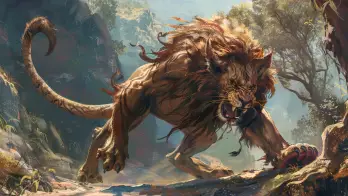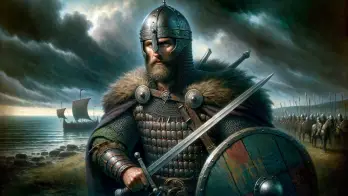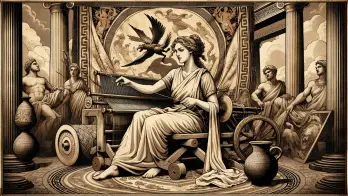Ancient Egypt mythology is incredibly complex and rich, with a vast pantheon of gods and goddesses, each with unique characteristics and stories.
The mythology also incorporated many aspects of daily life, including religious practices, social hierarchies, and beliefs about death and the afterlife.
The mythology of Ancient Egypt is one of the oldest and longest-lasting mythologies in the world, dating back to the pre-dynastic period around 5000 BC and continuing until the end of the Pharaonic era in 332 BC.
It was deeply rooted in the natural world, with many gods and goddesses associated with specific animals, plants, or natural phenomena. This connection to nature helped to reinforce the importance of the natural world in daily life and religious practices.
Furthermore, Ancient Egyptian mythology is shrouded in mystery and intrigue, with scholars still needing to fully understand many of the stories and rituals surrounding the gods and goddesses.
This sense of mystery has helped to captivate people’s imaginations for thousands of years.
Popular Egyptian Myths of the Birth of the Sun
In Ancient Egypt mythology, the sun was considered a powerful and important deity, and its birth was associated with several myths and legends.
Because of this, ancient Egyptians had many myths about the birth of the Sun.
The Myth of Atum: According to this Egyptian myth, Atum was the first god and creator of the world. He was said to have created himself out of the chaos before the universe was formed.
Atum then created the god of air, Shu, and the goddess of moisture, Tefnut, who gave birth to the sky and the earth. Finally, Atum gave birth to the sun god, Ra, who emerged from his forehead as a fiery ball of light.
The Myth of Horus: In this Egyptian myth, the goddess Isis gives birth to Horus, sometimes identified as the sun god.
Horus was conceived after his father, Osiris, was killed by his jealous brother, Seth. Isis used her magical powers to conceive Horus and hide him from Seth until he was old enough to avenge his father’s death. The Eye of Horus remains an important symbol today.
The Myth of Khepri: In Ancient Egypt mythology, Khepri was a scarab beetle god representing the rising sun. According to the legend, Khepri would roll the sun across the sky each day and then carry it through the underworld at night before bringing it back to life the next morning.
The Myth of Ra: Ra was the most important sun god in ancient Egypt, and his birth was often associated with the sunrise. According to Ancient Egypt mythology, Ra would be reborn each day as the sun rose in the sky and then travel through the underworld at night before being reborn the next morning.
The Celestial Cow Mehet-Urt
The Celestial Cow Mehet-Urt myth was one of the most significant creation myths in ancient Egypt and was believed to explain how the world was created and sustained by the goddess Hathor.
According to this Egyptian myth, Mehet-Urt emerged from the chaotic primeval waters that existed before the creation of the world.
She was described as a beautiful and powerful cow with a black coat, representing the fertile soils of the Nile valley, and a starry hide, symbolizing the heavens.
Mehet-Urt was said to give birth to the sun god, Ra, who emerged from her forehead as a glowing orb of light.
Ra was believed to be the most important of all the gods, and his daily journey across the sky was seen as a representation of the cycle of life and death.
Mehet-Urt was also associated with the goddess Nut, who was believed to be the arching sky that surrounded the world.
In this way, Mehet-Urt was seen as the physical manifestation of the heavens that nurtured and sustained all life on earth.
The Celestial Cow Mehet-Urt was also associated with fertility and abundance and was believed to provide sustenance to the gods and the people of Egypt.
Her milk was said to be a source of nourishment and was often depicted as a symbol of the Nile’s life-giving waters.
The myth of Mehet-Urt was an essential part of Ancient Egypt mythology and was often depicted in temple art and architecture.
It was believed that by honoring Mehet-Urt, the people of Egypt could ensure the continued fertility of the land and the prosperity of their communities.
The Role of Sacred Animals in Ancient Egypt Mythology
In ancient Egyptian mythology, animals played a significant role in religion and daily life.
Many animals were considered sacred and revered as embodiments of various deities. Their behavior, appearance, and habits were believed to reflect the divine qualities of the gods they represented.
The role of sacred animals in ancient Egypt mythology was multifaceted and can be categorized into several different aspects, including religious, symbolic, and practical roles.
Religious Role
Sacred animals were considered living manifestations of the gods and were worshipped and offered food, shelter, and care in temples dedicated to the gods.
They were often mummified and buried with great care and ceremony after their deaths, and their images and depictions were used in religious rituals and ceremonies.
Sacred animals were also believed to have special powers and abilities to be called upon in times of need or trouble.
Symbolic Role
Many sacred animals were believed to embody specific qualities and characteristics associated with the gods they represented.
One interesting ancient Egyptian legend that supports the role of sacred animals in ancient Egypt mythology is the legend of the goddess Bastet and the cat.
According to the legend, the goddess Bastet was often depicted as a cat or a woman with a cat’s head and was believed to embody the qualities of protection, fertility, and good luck.
In the legend, Bastet’s followers would keep cats in their homes to honor and appease the goddess, and the cats were treated with great respect and care. It was believed that by caring for the cats, the people could gain the favor and protection of the goddess Bastet.
In addition, the legend tells of an incident where a Roman soldier accidentally killed a cat in the city of Bubastis, the center of worship for the goddess Bastet.
The people were outraged and demanded that the soldier be punished for his actions, and the incident sparked a widespread revolt against Roman rule.
This legend illustrates the deep reverence and respect that the ancient Egyptians had for sacred animals and how their belief in the divine qualities of these animals was intertwined with their religious beliefs and cultural identity.
Similarly, the crocodile was associated with the god Sobek and was seen as a symbol of strength, power, and fertility.
Practical Role
In addition to their religious and symbolic roles, sacred animals also played functional roles in ancient Egyptian society.
For example, cattle were considered sacred and were used for plowing fields, transportation, and as a source of food and milk.
The cat was also valued for its ability to control rodent populations, and snakes were revered for their ability to control pests and vermin.
Overall, the role of sacred animals in ancient Egypt mythology was an integral part of the religious and cultural identity of the people.
The animals were revered, cared for, and treated with great respect. Their importance is reflected in the numerous depictions and representations found in art, literature, and architecture throughout ancient Egypt.
Creation Myths of Ancient Egypt: Memphite and Hermopolitan
Ancient Egyptian mythology has several legends about the world’s creation, but two of the most important and widely known are the Memphite and Hermopolitan creation myths.
The Memphite Creation Myth
The Memphite creation myth was one of ancient Egypt’s most essential and widely accepted creation myths.
According to the legend, the world was created by the god Ptah, who was believed to be the master of creation and the patron deity of craftsmen and architects.
In the beginning, the universe was a dark and formless void, and Ptah created the world by speaking it into existence. He created everything from the smallest grain of sand to the largest mountains and rivers, giving each thing its unique identity and purpose.
The myth goes on to say that Ptah created a triad of gods: Atum, Shu, and Tefnut.
Atum was the god of creation, and he emerged from the waters of chaos to bring order to the world. Shu was the god of air, and Tefnut was the goddess of moisture, and together they created the sky and the earth.
According to the myth, Ptah created the first humans, fashioned from clay on a potter’s wheel. These humans were made to work for the gods and maintain world order.
The Memphite creation myth was an essential part of ancient Egyptian religion and was often depicted in temple art and architecture.
The Hermopolitan Creation Myth
The Hermopolitan creation myth was another important creation myth in ancient Egypt and was associated with the city of Hermopolis in Upper Egypt.
According to the legend, the world was created by a group of eight gods known as the Ogdoad.
Initially, the universe was a formless and chaotic void, and the Ogdoad emerged from the primordial waters to bring order to the world.
The Ogdoad consisted of four pairs of male and female gods, each representing a different aspect of creation: air, water, darkness, and eternity.
The gods were believed to have created the universe by combining their powers, and they made a giant egg from which the sun god, Ra, emerged.
Ra was considered the most important of all the gods, and his daily journey across the sky represented the cycle of life and death.
The Hermopolitan creation myth was closely linked to the religious beliefs of the city of Hermopolis and was often depicted in temple art and architecture.
It was believed that by honoring the Ogdoad, the people of Egypt could ensure the continued fertility of the land and the prosperity of their communities.
The Divine Pleiad of the Ancient Egypt Mythology
The Divine Pleiad is a group of seven goddesses worshipped in Ancient Egypt.
In ancient Egypt mythology, the Pleiad were believed to be daughters of the god of wisdom and creation, Ptah, and the goddess of the sky, Nut.
The seven sisters were known by different names in various parts of Egypt, but the most commonly recognized names are:
- Isis
- Nepthys
- Hathor
- Neith
- Selket
- Maat
- Seshat
Each of the Pleiad had unique skills and responsibilities in Ancient Egyptian mythology. They were often depicted in art and literature in a group, as well as individually.
Isis: The Most Important of the Pleiad
According to ancient Egypt mythology, Isis was the most revered of the Pleiad and was worshipped throughout Egypt as the goddess of motherhood, fertility, and magic.
She was often depicted wearing a headdress in the shape of a throne, symbolizing her position as the queen of the gods. Isis was also believed to be the mother of the god of the afterlife, Osiris, and the goddess of love and beauty, Hathor.
Nepthys: The Protector of the Dead
Nepthys was the sister of Isis and was associated with the protection of the dead.
She was often depicted as a winged goddess or a woman with a falcon’s head. Nepthys was believed to be the mother of the god of death and mummification, Anubis.
Hathor: The Goddess of Love and Beauty
Hathor was the goddess of love, beauty, music, and joy. She was often depicted with cow horns and a sun disk, symbolizing her association with the sky and the sun. Hathor was also associated with the afterlife and was believed to guide the souls of the dead to the afterlife.
Neith: The Goddess of Hunting and Warfare
Neith was the goddess of hunting, warfare, and weaving. She was often depicted wearing a red crown or a bow and arrow, symbolizing her association with hunting and warfare.
Neith was also believed to be the creator of the universe and was associated with the city of Sais.
Selket: The Guardian of the Dead
Selket was the goddess of healing, scorpions, and the afterlife. She was often depicted as a woman with a scorpion’s tail or a scorpion with a woman’s head.
Selket was believed to be the guardian of the dead and was responsible for protecting the deceased’s body during mummification.
Maat: The Goddess of Truth and Justice
Maat was the goddess of truth, justice, and harmony. She was often depicted with an ostrich feather on her head, symbolizing truth and balance.
Maat was also associated with the concept of “ma’at,” which represented order, balance, and harmony in Ancient Egyptian society.
Seshat: The Goddess of Writing and Knowledge
In ancient Egypt mythology, Seshat was the goddess of writing, knowledge, and mathematics. She was often depicted wearing a headdress in the shape of a seven-pointed star, symbolizing her association with the Pleiad.
Seshat was believed to be the goddess of the “House of Books,” a place where important documents and knowledge were stored.
At Ancient Theory we only use trusted sources to document our articles. Such relevant sources include authentic documents, newspaper and magazine articles, established authors, or reputable websites.
- Egyptian mythology. wikipedia.org. [Source]
- James P. Allen - Genesis in Egypt: The Philosophy of Ancient Egyptian Creation Accounts. Yale Egyptological Seminar, 1988.
- Joshua J. Mark - Ancient Egyptian Mythology. worldhistory.org.
- Bob Brier - Ancient Egyptian Creation Myths: Of Water and Gods. wondriumdaily.com.
- Ancient Egyptian Creation Myths: From Watery Chaos To Cosmic Egg. glencairnmuseum.org.
- Ancient Egyptian Religion. britannica.com. [Source]






